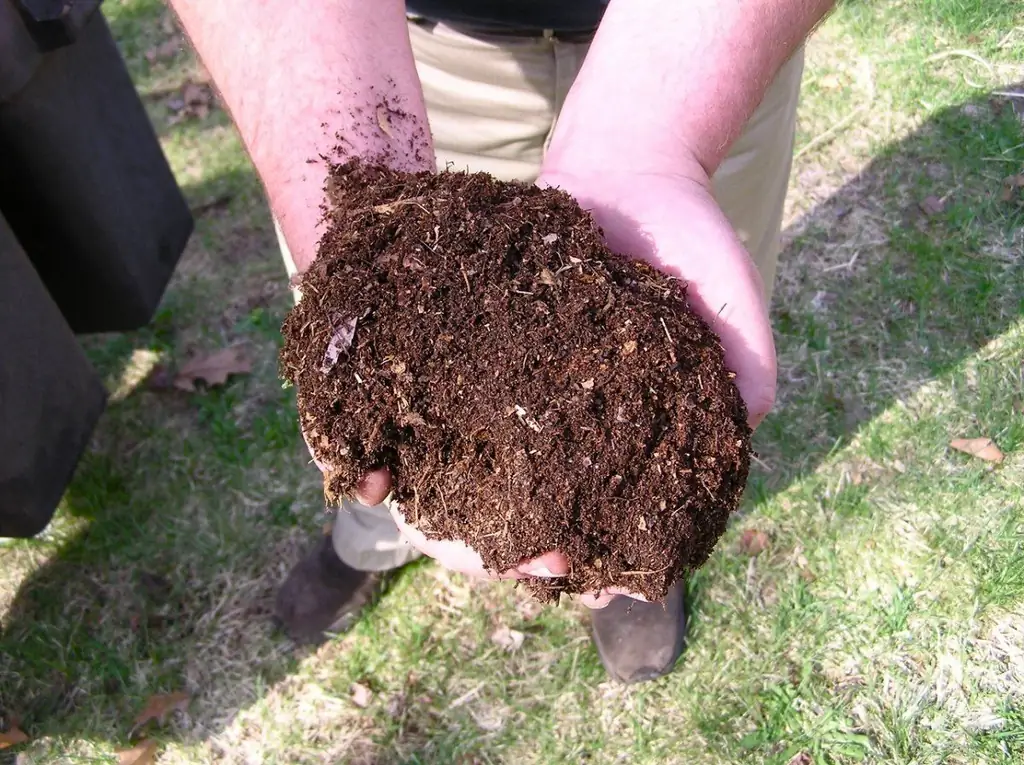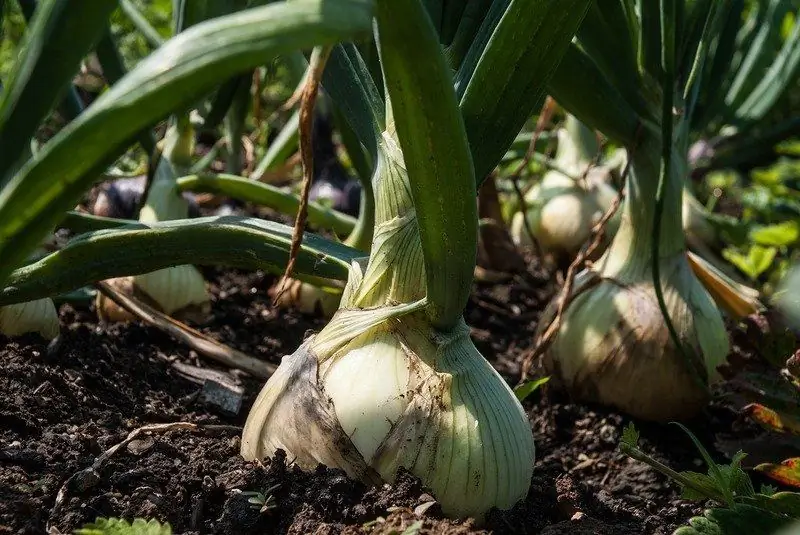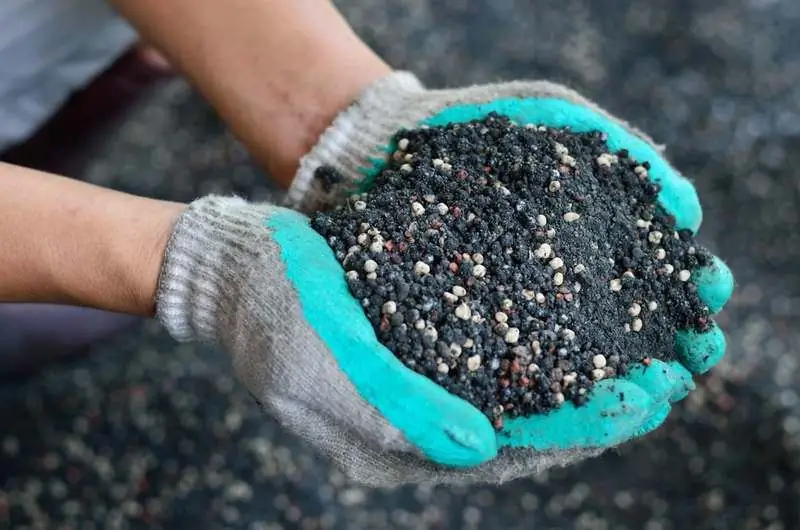
Table of contents:
- Author Bailey Albertson [email protected].
- Public 2023-12-17 12:53.
- Last modified 2025-06-01 07:32.
Top dressing potatoes when planting: what fertilizers can be put in the holes

The key to a good harvest is not only high-quality planting material, but also timely feeding during the entire growing season. Due to the peculiarities of the structure, potatoes need large doses of fertilizers to form large tubers. They are introduced both during the preparation of the beds, and into the hole, directly during planting.
Content
-
1 Do potatoes need fertilizers when planting in the ground
1.1 Video: necessary dressing when planting potatoes
-
2 What can be used
-
2.1 Purchased mineral and organic fertilizers
2.1.1 Video: Nitroammofosk and Ammofosk - which fertilizer to choose
-
2.2 Natural organics and folk remedies
2.2.1 Video: ash as fertilizer for horticultural crops
-
- 3 Reviews of gardeners
Do potatoes need fertilizers when planting in the ground
Top dressing for potatoes is imperative, without this it is impossible to collect a bountiful harvest. The crop stands out for its high intake of nutrients necessary for tuber formation. In order for 1 kg of root crops to ripen, you need 10-12 g of potassium, 4-5 g of nitrogen, 2-3 g of phosphorus, 1-1.5 g of magnesium and other trace elements (copper, zinc, manganese, boron).

Potato tubers consume a lot of nutrients, so it is impossible to grow it without top dressing
The superficial and relatively poorly developed root system does not reach the deep layers of the soil to get everything you need from there. Therefore, it is impractical to fertilize the entire area of the garden. In the fall, in the process of digging the soil, it is recommended to apply only humus every 3-5 years to maintain the fertility of the substrate. The volumes depend on the quality of the soil. If the soil is completely depleted, apply about 10 kg / m², otherwise - 2-3 kg / m².

The root system of potatoes is superficial and not particularly branched - in diameter it roughly coincides with the shadow cast by the bush
Mineral dressings are added directly to the hole during planting. Thus, the consumption of fertilizers is much less, and they are immediately delivered "to the address". The addition of organic matter at this time is also beneficial. Any dressing, even natural, must be sprinkled with earth or mixed with it. Direct contact with the planted tubers is undesirable.

The introduction of substances necessary for potatoes directly into the holes allows you to significantly reduce the consumption of fertilizers
Video: necessary fertilizing when planting potatoes
What can be used
Under the potatoes, you can apply both store-bought mineral fertilizers and natural organic matter. It depends on the gardener's preference. The main thing is not to overdo it. An excess of nutrients has a bad effect on the immunity of plants, ensures the active development of the aerial part to the detriment of the tubers.
Purchased mineral and organic fertilizers
Many gardeners are afraid to use mineral nitrogen fertilizers, believing that this will provoke an increased content of nitrates in tubers. But this is only the result of exceeding their dosage. And you can't do without nitrogen, in the early stages of development it is vital for plants for active growth.

Do not be afraid to use nitrogen fertilizers - just before that, study the manufacturer's recommendations and observe the indicated dosage and frequency of their introduction
You can add to the hole:
- Carbamide (urea). Most useful in alkaline soils. Granules (10-15 g) are added to the well in dry form or spilled with a solution (40 g / 10 L). The liquid consumption rate is about 0.5 liters per well.
- Ammonium nitrate. Highly concentrated nitrogen fertilizer, effective at minimum consumption. The specific dosage depends on the fertility of the soil and varies from 2-3 to 6-8 g per well. You can also prepare a solution - 15 g per 10 liters of water, 0.5 liters per well.
- Azofosku. In addition to nitrogen in a form available for easy assimilation by plants, it contains phosphorus, potassium, sulfur. Such a composition ensures the rapid development and strengthening of the root system, active growth of tubers and their "heap" formation, protects the crop from pathogenic fungi. The rate per well is 3 g. Other complex fertilizers - Nitrofosk, Diammofosk, Karbofosk are applied at about the same dosage.

Azofoska is a popular fertilizer among gardeners, containing three "basic" macronutrients - nitrogen, phosphorus, potassium (this is clear even from the name)
Video: Nitroammofosk and Ammofosk - which fertilizer to choose
Also use:
-
Superphosphate (single or double). Best for acidic soil. In the composition - phosphorus, calcium and sulfur. Fertilizer not only activates the growth of tops, but also helps the tubers absorb nutrients. Superphosphate is not recommended to be mixed with other mineral fertilizers, its effectiveness decreases markedly. The application rate is 4-5 g of double superphosphate per well, and twice as much as a simple one.

Superphosphate Superphosphate can be simple and double, respectively, the recommended dosage also changes
-
Potassium sulfate. Potassium is essential for the ripening of tubers, it also improves their taste. It is used together with organic or nitrogen fertilizers. The norm per hole is 12-15 g. The highest content of the macroelement is in potassium chloride, but it is not suitable for potatoes, the culture does not tolerate chlorine.

Potassium sulfate Potassium sulfate can be sold under the names "potassium sulfate" or "potassium nitrate"
-
Potato Kemira. One of the most popular compound fertilizers among gardeners. Provides the formation of large tubers and a greater keeping quality of the crop. Useful components - nitrogen, phosphorus, potassium, magnesium, sulfur. In the holes, 20 g is added.

Fertilizer Kemira potato Kemir potato fertilizer, like other complex store-based feedings, contains macro- and microelements necessary for the culture in the correct proportion
-
Gumi-Omi. Improves soil fertility, helps to form a layer of humus, and helps to increase the size of tubers. In the composition - salts of humic acids, nitrogen, phosphorus, potassium, sodium. The norm is 10-12 g per well.

Fertilizer Gumi-Omi Fertilizer Gumi-Omi is both a means for feeding potatoes and for increasing the fertility of the substrate.
Natural organics and folk remedies
Biofertilizers - waste products of animals, plants, organic waste, exposed to a certain effect of microorganisms. They not only increase the fertility of the substrate, but also improve its texture, making the soil looser, lighter and more breathable. These are complex dressings that the potatoes respond to in the best way. Suitable for placing in the holes before planting:
-
Overripe manure (or compost). In the process of decomposition, it releases heat, accelerating the development of tubers and protecting them from possible frost, which is especially valuable in the northern regions. Rich in macro- and microelements (nitrogen, phosphorus, potassium, calcium, magnesium, manganese, boron, cobalt). The average rate is a handful (100-150 g per well). Fresh manure cannot be used - eggs and larvae of pests, spores of pathogenic fungi successfully winter in it, and in the process of its decomposition ammonia is released, which destroys beneficial soil microorganisms. The ripening process takes at least two years.

Humus Humus is a natural remedy for increasing soil fertility, but its benefits for horticultural crops are not limited to this.
-
Slurry. Prepared if the gardener has only fresh manure at his disposal. It is diluted with water 1: 9 and poured a liter of liquid into each well.

Slurry Fresh manure, if there is no alternative to it at hand, can also be turned into fertilizer for potatoes
-
Chicken droppings. Highly concentrated fertilizer with nitrogen, phosphorus and potassium content, which is used only in diluted form. An infusion is prepared from the droppings, pouring 700 g of fresh raw materials with 3-5 liters of warm water. The container is tightly closed and left warm for 3-4 days. A characteristic smell indicates the beginning of the fermentation process. Before use, the solution is filtered, diluted with water in a ratio of 1:15 and the wells are poured (one liter in each). In stores, you can buy granulated chicken manure, ready to use. Its dosage is indicated in the instructions.

Infusion of chicken manure Fresh chicken manure is never used as a top dressing
-
Green infusion. It is prepared from any weeds, most often from nettles and dandelions. The weathered grass, tamping tightly, fill the barrel by about a third. Add 2-3 handfuls of any nitrogen fertilizer if desired. The container is poured to the brim with water, sealed with polyethylene and left in the sun for 10-15 days for fermentation. Before use, filter the liquid, dilute with water 1: 5. The norm is a liter per well.

Weeds from the garden Weeds cut from the beds can be used by preparing a useful complex fertilizer
-
Wood ash. In addition to phosphorus and potassium, it contains calcium, manganese and boron. Top dressing improves the quality of the soil, has a positive effect on the quantity and quality of tubers. Ash is best used on acidic soils, bringing their acid-base balance to neutral. It is brought in both dry and as an infusion (0.5 liters of raw materials per 3 liters of boiling water, strain after 3 hours). For each hole - a handful of dry ash or a liter of infusion. You can combine it with potash or complex (nitrogen-phosphorus-potassium) fertilizers.

Wood ash Only wood ash can be used as fertilizer; it is recommended to sift it first
Video: ash as fertilizer for horticultural crops
Gardeners reviews
Any substrate is inevitably depleted over time, because plants are constantly drawing nutrients from the soil. As a result, the yield of potatoes and the quality of tubers fall. To prevent this from happening, you need to regularly apply fertilizers to the soil, restoring the fertility of the substrate. Potatoes react positively to both organic and mineral dressings, it is only important to calculate the dosage correctly. Fertilizers are most needed for him at the initial stage of development, so it is most advisable to introduce the necessary nutrients into the hole when planting.
Recommended:
Description Of Organic Fertilizers And Their Use (with Video)

Types of organic fertilizers, practical recommendations for the production and use of compost and other fertilizers
The Use Of Organic Fertilizers In The Garden + Video

Organic fertilizers in gardening works; manufacturing, application, materials used
How To Feed Onions So That They Are Large: Organic And Mineral Fertilizers, Folk Remedies

How can you feed the onion so that it is large. Mineral and organic fertilizers. Folk remedies
How To Feed Peppers During Flowering And Fruiting: Mineral, Organic And Folk Remedies

Top dressing suitable for pepper: mineral and organic fertilizers, folk remedies - description, frequency of application. Reviews and recommendations of gardeners
Autumn Fertilizers For The Garden And Vegetable Garden: When To Apply And The Better To Feed The Soil

Why feed plants in the fall. Types of autumn fertilizers. Which are suitable for digging soil and feeding trees, shrubs and perennial flowers
